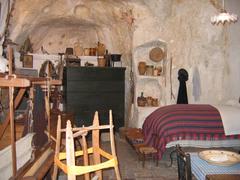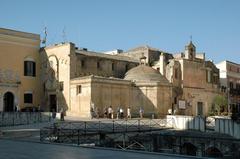Palazzo Lanfranchi Visiting Hours, Tickets, and Guide to Matera Historical Sites
Date: 04/07/2025
Introduction
Palazzo Lanfranchi, located in the heart of Matera, is a striking symbol of the city’s enduring cultural heritage and architectural grandeur. Originally built in the 17th century as an ecclesiastical seminary, this Baroque palace has been central to Matera’s historical evolution. Overlooking the renowned Sassi di Matera and the Murgia plateau, Palazzo Lanfranchi is now the prestigious National Museum of Medieval and Modern Art of Basilicata, playing a key role in Matera’s status as a UNESCO World Heritage Site and a European Capital of Culture. Visitors are treated not only to remarkable art collections and exhibitions but also to panoramic views of one of Italy’s most mesmerizing urban landscapes (Discover Matera’s Attractions, Italia.it, Delightfully Italy).
Table of Contents
- Origins and Architectural Development
- Historical Significance in Matera’s Urban Fabric
- Transformation into a Cultural Hub
- Visitor Information: Visiting Hours, Tickets, and Accessibility
- Key Historical Events and Figures
- Architectural Features and Preservation
- Role in Matera’s Contemporary Identity
- Visitor Experience and Interpretation
- Timeline of Notable Milestones
- Historical Context within Matera’s UNESCO Status
- Frequently Asked Questions (FAQ)
- Discovering the Artistic and Architectural Significance
- Visiting Guide: Hours, Tickets, Facilities, and Nearby Attractions
- Summary and Visitor Recommendations
- Sources and Further Reading
Origins and Architectural Development
Constructed between 1668 and 1672 under the commission of Bishop Vincenzo Lanfranchi, the palace was designed by the Capuchin friar Francesco da Copertino according to Tridentine dictates for ecclesiastical buildings. Its Baroque architectural style is evident in its grand halls, intricate frescoes, cloister, and stately façade. Originally serving as a diocesan seminary, Palazzo Lanfranchi’s placement within the city’s center underscores its importance as both a religious and civic landmark (Discover Matera’s Attractions, Italia.it).
Historical Significance in Matera’s Urban Fabric
Palazzo Lanfranchi is interwoven with Matera’s development as one of the oldest continuously inhabited cities in the world. Its construction marked a period of urban expansion that emphasized Matera’s emerging role as a regional center for religious and administrative authority. The palace’s proximity to the Sassi — the city’s famed cave dwellings — positions it as a bridge between ancient and modern Matera (Matera Travel Guide).
Transformation into a Cultural Hub
In the late 20th century, as Matera’s unique heritage gained international recognition, Palazzo Lanfranchi was restored and repurposed as the National Museum of Medieval and Modern Art of Basilicata. The palace now houses extensive collections of medieval sacred art, Baroque masterpieces, and contemporary works, including notable pieces by Carlo Levi. It also serves as a venue for temporary exhibitions, concerts, and cultural events, making it a dynamic center for artistic exchange (Discover Matera’s Attractions, Museo Nazionale di Matera).
Visitor Information: Visiting Hours, Tickets, and Accessibility
Visiting Hours:
- Monday, Wednesday–Sunday: 09:00–20:00 (last entry 19:00)
- Tuesday: 14:00–20:00 (last entry 19:00)
Hours may vary during holidays or special events; verify on the official museum website before visiting.
Ticket Prices:
- Adults: €10.00
- Combined Ticket (all National Museum sites, valid 2 days): €15.00
- Annual Pass (all National Museum sites): €25.00
- Students (per site): €2.00
- Ages 18–25: €2.00
- Under 18s, military, law enforcement, journalists, academics: Free
- Free entry on the first Sunday of each month and select national holidays.
Accessibility:
- Wheelchair-accessible entrance via a ramp at Piazzetta Giovanni Pascoli.
- “Museo per tutti” guides in Easy to Read format and with AAC symbols.
- Guide dogs permitted; small dogs may be carried.
- Ramps and elevators available throughout the museum.
Guided Tours and Amenities:
- Guided tours in Italian and English are available; audio guides can be rented.
- Facilities include a ticket office, restrooms, cloakroom, library, and bookshop.
- Photography for personal use is permitted; publication requires prior authorization.
Key Historical Events and Figures
Palazzo Lanfranchi is closely associated with Carlo Levi, the Italian writer and artist whose exile in Basilicata inspired his celebrated book “Christ Stopped at Eboli.” Levi’s paintings, especially the monumental “Lucania ’61,” are among the museum’s highlights, offering insight into the region’s 20th-century social and cultural landscape (Discover Matera’s Attractions).
Architectural Features and Preservation
The palace features a Baroque façade with five niches containing statues of saints, a pediment with an 18th-century clock, and a cloister that serves as the building’s architectural heart. The interiors include grand staircases, vaulted ceilings, and original frescoes, while the central cloister is adorned with a sundial and commemorative busts. Meticulous restoration has preserved these elements while integrating modern amenities for accessibility and visitor comfort (Italia.it, Italyscapes.com).
Role in Matera’s Contemporary Identity
As a key participant in Matera’s transformation into a cultural tourism destination, Palazzo Lanfranchi is central to city-wide programs such as the European Capital of Culture. Its exhibitions and events draw visitors from around the globe, contributing to Matera’s dynamic contemporary identity (Matera Travel Guide).
Visitor Experience and Interpretation
Visitors benefit from guided tours, interpretive materials, and rotating exhibitions. The palace’s location on Piazza Pascoli makes it ideal for exploring other Matera attractions. Educational programs and workshops engage audiences of all ages and backgrounds, while the museum’s Ethnographic Section at the nearby ex Ospedale San Rocco offers further insight into Lucanian agro-pastoral traditions (Musei Matera).
Timeline of Notable Milestones
- 1668–1672: Construction as a diocesan seminary.
- 19th–20th Centuries: Used for various civic functions, including as a high school.
- Late 20th Century: Restoration and conversion into a museum.
- 2019: Matera designated European Capital of Culture; Palazzo Lanfranchi central to the program.
- Present: Serves as the National Museum of Medieval and Modern Art of Basilicata.
Historical Context within Matera’s UNESCO Status
Palazzo Lanfranchi is a vital part of Matera’s UNESCO designation. Its adaptive reuse, architectural integrity, and role in the city’s cultural renaissance illustrate best practices in heritage management (Discover Matera’s Attractions, Italia.it).
Discovering the Artistic and Architectural Significance
Baroque Architecture and Urban Context
The palace is Matera’s finest Baroque example, with an asymmetric façade divided into two horizontal orders, crowned by a pediment and clock. The central cloister, arcaded and sunlit, is flanked by commemorative busts and a sundial. The façade’s five niches with statues of saints serve as a visual catechism (Italyscapes.com, Materasassiemurgia.com).
Museum Layout and Notable Collections
The National Museum of Medieval and Modern Art of Basilicata, housed within the palace, is divided into three main sections:
- Sacred Art: Paintings, sculptures, and liturgical objects from the region’s churches.
- The D’Errico Collection: Baroque and 17th-century works collected by the D’Errico family, including paintings by Neapolitan and southern Italian masters.
- Contemporary Art: Works by Carlo Levi, Luigi Guerricchio, and Mario Carbone, including Levi’s “Lucania ’61” (Museo Nazionale di Matera, Artsupp.com).
An Ethnographic Section at ex Ospedale San Rocco highlights Lucanian traditions and communal life (Musei Matera).
Integration with the Urban Landscape
Situated on Piazza Pascoli, Palazzo Lanfranchi offers sweeping views of the Sassi districts and the Murgia plateau, blending Baroque refinement with Matera’s rugged stone landscape (Voyagetips.com).
Visiting Guide: Hours, Tickets, Facilities, and Nearby Attractions
Location: Piazza Giovanni Pascoli, 1, 75100 Matera, Italy
Getting There:
- By Train/Bus: Nearest Trenitalia stations are Bari and Ferrandina; FAL and bus connections available.
- By Air: Bari Palese Airport, with Pugliairbus service to Matera.
- By Car: Accessible via SS 407 “Basentana”; parking available nearby.
Facilities:
- Ground floor ticket office and visitor assistance
- Library, photo archives, and documentation center
- Accessible restrooms and cloakroom
- Bookshop with local crafts and art publications
Guided Tours & Photography:
- Guided tours in Italian and English; audio guides available
- Personal photography allowed (no flash/tripods); publication requires permission
Best Times to Visit:
- Spring and autumn for mild weather
- Early mornings or late afternoons for fewer crowds
- Annual events like Festa della Musica for special exhibitions
Nearby Historical Sites:
- Sassi di Matera (6-minute walk)
- Matera Cathedral (6-minute walk)
- Castello Tramontano, Chiesa del Purgatorio, Church of Santa Maria di Idris
- Museo-laboratorio della Civiltà Contadina
Frequently Asked Questions (FAQ)
Q: What are Palazzo Lanfranchi’s opening hours?
A: Monday, Wednesday–Sunday: 09:00–20:00; Tuesday: 14:00–20:00. Last entry at 19:00.
Q: How much are tickets?
A: Standard: €10. Combined and annual passes available; discounts for youth and students.
Q: Is the palace accessible?
A: Yes, with ramps, elevators, and special guides for visitors with disabilities.
Q: Can I take photos?
A: Personal photography permitted; publication requires permission.
Q: Are guided tours available in English?
A: Yes, by arrangement.
Q: How do I reach Palazzo Lanfranchi by public transport?
A: Via FAL trains/buses from Bari or Ferrandina; Pugliairbus from Bari Airport.
Q: Are there combined tickets for other museums?
A: Yes, combined tickets include entry to the Ethnographic Section and other National Museum sites.
Summary and Visitor Recommendations for Palazzo Lanfranchi
Palazzo Lanfranchi is a cornerstone of Matera’s historical and artistic identity. Its Baroque architecture, sweeping city views, and carefully curated collections—spanning sacred art, Baroque masterpieces, and modern works by figures such as Carlo Levi—offer a comprehensive journey through Basilicata’s cultural landscape. The palace’s commitment to accessibility, educational programming, and community engagement ensures a welcoming experience for all visitors (Discover Matera’s Attractions, Museo Nazionale di Matera, Italia.it, Musei Matera).
For an enriched visit, plan to explore the palace’s exhibitions, participate in a guided tour, and take time to enjoy panoramic vistas from Piazza Pascoli. Take advantage of combined tickets to nearby museums and check the calendar for special events or temporary exhibitions. Before your visit, consult the official museum website for up-to-date information and consider downloading the Audiala app for digital guides and insider tips. Palazzo Lanfranchi is truly an essential stop for anyone seeking to connect with the spirit and history of Matera (Delightfully Italy, Earth Trekkers).
Sources and Further Reading
- This is a sample text. (Discover Matera’s Attractions)
- This is a sample text. (Palazzo Lanfranchi Visiting Hours, Tickets, and History | Matera Historical Sites)
- This is a sample text. (Museo Nazionale di Matera Brochure)
- This is a sample text. (Matera Travel Guide)
- This is a sample text. (Italia.it - Museo Nazionale di Matera)
- This is a sample text. (Delightfully Italy)
- This is a sample text. (Musei Matera Official Website)
- This is a sample text. (Earth Trekkers)
- This is a sample text. (Italyscapes.com)


